Ancient Ships in art history: The navy of King Solomon and Isreal
New American Standard Bible
21All King Solomon’s drinking vessels were of gold, and all the vessels of the house of the forest of Lebanon were of pure gold. None was of silver; it was not considered valuable in the days of Solomon. 22For the king had at sea the ships of Tarshish with the ships of Hiram; once every three years the ships of Tarshish came bringing gold and silver, ivory and apes and peacocks. 23So King Solomon became greater than all the kings of the earth in riches and in wisdom. 24All the earth was seeking the presence of Solomon, to hear his wisdom which God had put in his heart. 25They brought every man his gift, articles of silver and gold, garments, weapons, spices, horses, and mules, so much year by year.
26Now Solomon gathered chariots and horsemen; and he had 1,400 chariots and 12,000 horsemen, and he stationed them in the chariot cities and with the king in Jerusalem. 27The king made silver as common as stones in Jerusalem, and he made cedars as plentiful as sycamore trees that are in the lowland. 28Also Solomon’s import of horses was from Egypt and Kue, and the king’s merchants procured them from Kue for a price. 29A chariot was imported from Egypt for 600 shekels of silver, and a horse for 150; and by the same means they exported them to all the kings of the Hittites and to the kings of the Arameans.

Silk Road
One particular area of interest, which is central to the story of Solomon, was the fact that he was credited with having employed a large Naval force in the conduct of his trade. In addition to having a navy Solomon is credited with being a shrewd diplomat with alliances to the kingdoms of Sheba, Egypt, and Phoenicia all of which were known to have had extensive seafaring capabilities at this time in ancient history. The Queen of Sheba alone was credited with having over 400 seafaring ships for conducting trade.
 |  |
Jewish history credits Solomon with having been successful in diplomacy and trade with the majority of his neighbors. A prime example of this diplomacy was mentioned in 1 Kings Chapter 5. Which relates his alliance with the ruler of Tyre, which was the chief seaport of the Phoenicians at that time. It was these key alliances in trade, diplomacy and the ability to keep the peace that lead to the apparent success of his administration. Other trading alliances credited to Solomon were with, Chittim, Ophir and Tarshish. Add to this list a list of countries from which Solomon took wives and he can truly be said to have been be a figure of international reputation.
Israel was located at the crossroads of the Levant. The historic records from other contemporary cultures before and leading up to the time of Solomon show this geographic region to have been a very volatile area and was usually governed as a vassal state of one of the more prominent powers in the Region. It is apparent from these records that the region had fallen into political turmoil after the onset of invasions by the Sea Peoples against Egypt in 1250 BCE. The early invasions exploits of Merneptah 1224-1210 BCE against the Sea Peoples are recorded as relief murals at Karnak. The later invasions of the sea peoples that were repulsed during the rule of Rameses III and are recorded at Mendinet Habu in graphic detail. Egypt's influence, political and military dominance was not asserted again until the Palestinian campaign of Shishak 1 following the reign of Solomon in 941 BCE. This was the same historic time frame in which the Hebrews Colonized the Levant according to the Biblical account. See Timelines and Events
The concept that Solomon had and maintained a naval force is key to understanding the success of his administration. Without understanding the extent to which sea trade effected the economy of the Eastern Mediterranean nations it would be difficult to understand much at all about the foreign policy and diplomacy of Israel during this historic time frame.
One of the most interesting stories that suggests the extent of travel and trade that occurred in the prehistoric era is the Milesian Myth of the Irish. This myth is considered to be legend and falls outside of the classification of history but the story line intimates the extent to which travel, trade and colonization may have occurred in the ancient world. One account of this story attributes Milesius to be the brother in law of Solomon. This would be the case if both were married to the daughters of the same Egyptian Pharaoh, considering each had Egyptian wives.
By the Melisian Myth account travel and trade occurred between the British Isles, the Spanish Coast, the Mediterranean Island Nations, the Coastal cities located in region of the Black Sea, and the eastern Mediterranean coastal cities including the Egyptian Delta as early as 1700BCE. The Irish Milesians are not to be confused with the Miletian Greeks from Lydia. It is tempting to indulge in conjecture that although we do no have a reliable written record to verify this extensive travel did indeed occur.
It is speculated that navigation was accomplished not in the open ocean but primarily by short hops along and within view of coastlines. For merchant ships powered by sail a daily sailing effort would have covered from 50 to 75 miles under good conditions. Travel and extended trade may have been more prevalent than previous conservative estimates suggest. The best archeology confirming some of the extent of travel and trading patterns are the Uluburun Bronze Age Shipwreck and shipwreck at Cape Gelidonya on the Turkish coast. Both cargos suggest trading patterns that covered a wide territory including parts of Africa and the Middle East.

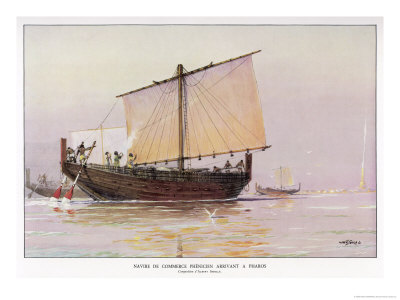


Written records verify trading patterns of the Egyptians included travel through the Red Sea to sub-Saharan Africa as far a Somalia, along the western coast as early 2450BCE. The fact that trade was conducted south makes it easy to speculate that similar length journeys would have been made into Mediterranean basin. The most adventuresome of estimates suggest that the Negroid features found on sculptures in Messo-America are due to the fact Africans did indeed arrive by sea in the western hemisphere as early as 1700BCE.
Considering the fact that the history of the Levant indicates that it was generally void of strong civil government from the time of the Exodus until the time of Solomon, the ability of his administration to maintain the peace, conduct adequate diplomacy for trade and to guarantee the safety of his kingdom was nothing less than a formidable task.
Archeological clues along the coastal Levant strongly suggest that the city states of coastal Levant were for many centuries trading outposts of the Cypro/Minoan and Mycenaean cultures.
Solomon according to Biblical accounts had good relations with Hiram the Phoenician ruler of Tyre (the foremost seafaring nation in the Eastern Mediterranean) to the extent that this foreign king assisted Solomon in the creation of a naval force. This piqued my curiosity as to the likely appearance and structure of the naval forces of Solomon and to find out what seafaring technologies were available at the time to put a naval force to sea.
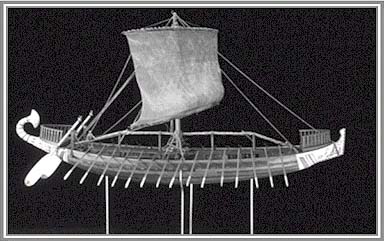
Hatshepsut's Naval Vessels from the 15th Century BCE
Solomon's Naval capability may have been modeled after this type of ship
This web folder is an overview of the iconography of ships, naval technologies and developments in antiquity leading up to and encompassing the time of Solomon Circa 1000BCE. The ships and boating illustrated here are my findings from the Internet. This material will be incorporated into a larger work called "Discovering the Historic Solomon" which will highlight the various crafts and technologies in the Eastern Mediterranean region, where they were developed and how they may have been applied in the Levant by the early Hebrew Culture. This web folder constitutes an overview of the Iconography of the ship from the earliest recorded history and a display of the modern models and illustrations of ancient ships.
As a result of creating the Ships of Antiquity I have concluded that probably no other technology in the history of man has been more important to the spread of civilization, culture and trade in the world than that of the seafaring ship.
2nd Chronicles Chapter 9
Time slot 1000 BCE
The Bible which is consedered by many to be the primary record of Jewish history clearly records the relationships in ancient history that Solomon's Kingdom had with the seafaring nations of the Eastern Mediterranean. Phoenicia, Sheba, Chittim, Tyre, Tarshish, Ophir and Egypt were all sea faring nations and/or trading partners of Israel. The entire chapter nine of 2nd Chronicles is a record of Solomon's political alliances for trade. Determining the exact location of and realm of influence of the individual trading partners during Solomon's time is a matter of conjecture and additional scholarship.
Tarshish is taken to the coastal area of Spain near current day Seville and Cartegena. The Tarshish realm of influence would have included the islands of Corsica, Sardinia, Sicily and Malta.
It it interesting to note that Irish folklore tells a story of ancient history specifically the Melisian myth, indicating trade occurred between Spain, the Coastal cities of the Black Sea, the coastal Levant, the Egyptian Delta and the British Isles. In my research I have looked for the indicators that this in fact did occur. I have found strong similarities in Iconography between Minoan artifacts, artifacts found in Peloponnesian and Irish burial tombs and mounds from the same chronological periods.
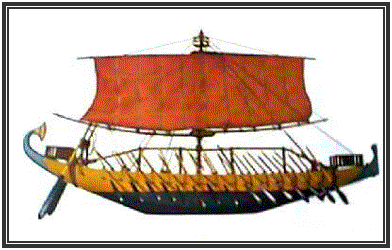
Egyptian Naval Vessel of 1250 BCE
The Bible clearly indicates the Princes of Tyre to be wealthy merchants controlling the sea trading routes in the Eastern Mediterranean, including, Tarsus, Byblos, Tyre, Sidon and until the time of Solomon El-dor, which is credited with becoming the primary sea port of Israel in the Eastern Mediterranean during the reign of King Solomon.
Phoenicia prospered as a trading nation until the time of the Assyrian conquests. At this time it is recorded in the book of Isaiah that the Phoenicians fled in their boats to settle elsewhere. History shows us they fled to the Geographical area of Tunisia in Northern Africa and established Carthage as their Primary Trading post.
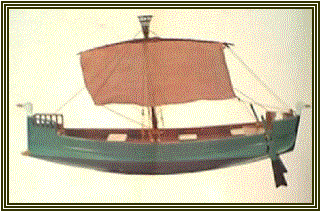 The Biblical reference to Isreal and King Solomon trading with the country of Ophir remains a little more shrouded in Mystery. There are indicators in the Bible as to its possible location if you read the clues. It is mentioned that the Voyages going to Ophir left the Ports cities in the gulf of Aquaba and didn't return with their trade items until taking a round trip that lasted three years. The bible also indicates that these journeys were a joint venture of Solomon and Hiram of Tyre. This story indicates that Phoenicia was already in trade with Ophir before Solomon struck his alliance with Hiram.
The Biblical reference to Isreal and King Solomon trading with the country of Ophir remains a little more shrouded in Mystery. There are indicators in the Bible as to its possible location if you read the clues. It is mentioned that the Voyages going to Ophir left the Ports cities in the gulf of Aquaba and didn't return with their trade items until taking a round trip that lasted three years. The bible also indicates that these journeys were a joint venture of Solomon and Hiram of Tyre. This story indicates that Phoenicia was already in trade with Ophir before Solomon struck his alliance with Hiram. Sheba located on the southern Arabian Peninsula and its Realm of Influence including the Horn of Africa. Sheba based on its location would have controlled the eastern and southern trade routes through the Red Sea. The Saba Kingdom happened to control Trade routes South of the Gulf of Aquaba both overland and with ports on the Red Sea. Therefore Saba would have controlled access to the eastern African coast, the Arabian Gulf, and India.
The Bible clearly indicates the Princes of Tyre to be wealthy merchants controlling the sea trading routes in the Eastern Mediterranean Including, Tarsus, Byblos, Tyre, Sidon and until the time of Solomon El-dor, which is credited with being Israel's primary sea port on the Mediterranean. This idea is supported by the riches of art history from the region.
Phoenicia prospered as a trading nation until the time of the Assyrian conquests. At this time it is recorded in the book of Isaiah that the Phoenicians fled in their boats to settle elsewhere. History shows us they went to Northern Africa and established Carthage as their Primary Trading port.
The other indicator as to Ophir's location are the descriptions of contents of the cargo's coming from Ophir. Scriptures indicate that these cargos contained ivory, apes, peacocks, algum trees and spices. This description of the cargos point to India as being Ophir particularly the Peacocks. The other indicator that Ophir may in fact be India is the fact that the journeys to and from Ophir were said to take as long as three years which indicates a very long distance travel route. Travel in open seas covering of distances of this kind were generally done during favorable weather conditions. The traders would have traveled during the season's that best assured their safety at sea and gave them favorable winds for their primary direction of travel.
Below are a few excerpts from the Bible.
2nd Chronicles
8:17 Then went Solomon to Ezion-geber, and to Eloth, on the seashore in the land of Edom.
8:18 And Hiram sent him by his servants ships, and servants that had knowledge of the sea; and they went with the servants of Solomon to Ophir, and fetched thence four hundred and fifty talents of gold, and brought them to king Solomon.
"Surely the islands look to me; in the lead are the ships of Tarshish, bringing your sons from afar, with their silver and gold, to the honor of the LORD your God, the Holy One of Israel,
for he has endowed you with splendor."
Isaiah 60:9 - NIV
For further reading on the trade relationships of Solomon read 2nd Chronicles Chapter 9.
Solomon would have had access and knowledge of the seafaring technologies of the Phoenicians and Egyptians and most likely used this knowledge and his political alliances to build ships in each in these
classes.
Some idea of these men-of-war, which sailed with the merchant fleet from Ezion-geber, can be obtained from the bas-reliefs (now in the British Museum) which were formerly used as ornaments in the royal palace of the Assyrian king of Sennacherib (704-681) see illustration below. The vessel was powered by sail, but in order to maneuver more rapidly against a possible enemy it could be propelled by oars. There were two rows of oarsmen. In the bow, at water level, was a ram for the purpose of holing and sinking enemy ships. Above the galley slaves was an open bridge. Above the breastwork there were men at arms ready to act as a boarding party. Hiram knew all about organizing a trading voyage; Solomon had no cause for anxiety.
961-922: Solomon: King of Israel, Jerusalem Temple, "Ten Commandments", height of culture, reign of peace, controlled Via Maris (Sea Road) trade route along Philistian coast, leading trade state between Egypt & Asia Minor, married Pharaoh's daughter, spice trade with Queen of Sheba (Sabaeans?), sea route from Ezion-geber on Red Sea to Ophir Africa, mines
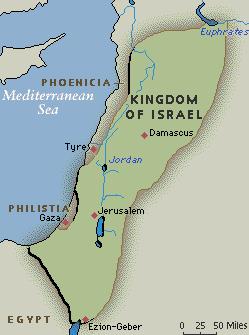
Israel under King Solomon





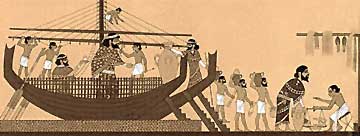
Tidak ada komentar:
Posting Komentar